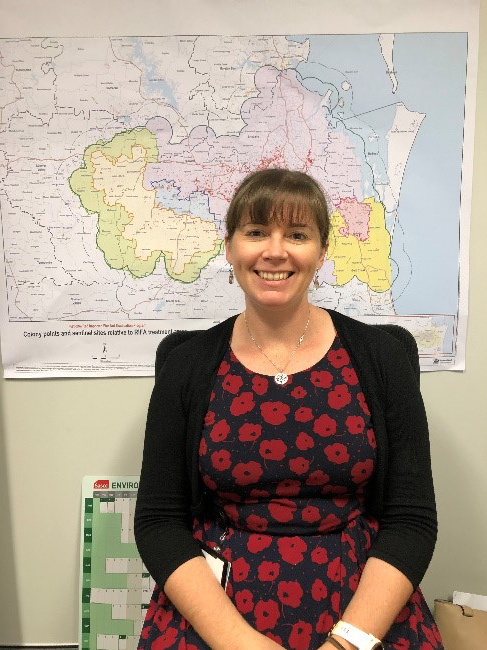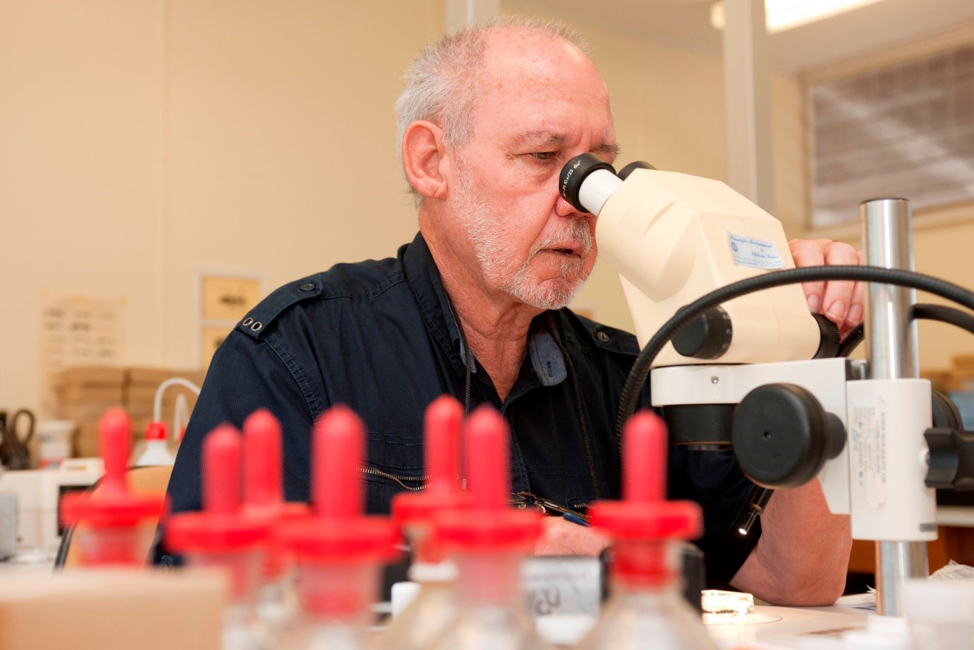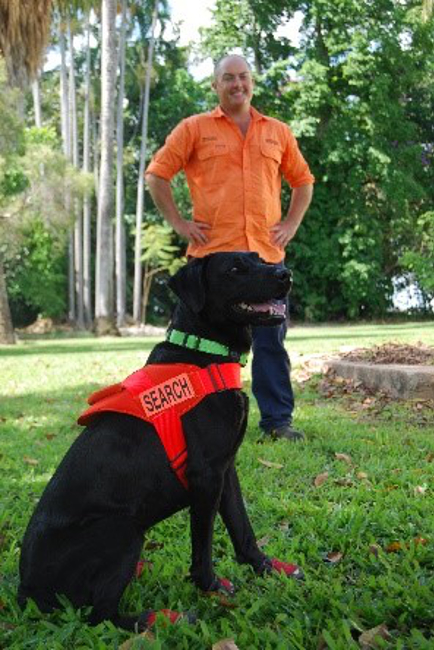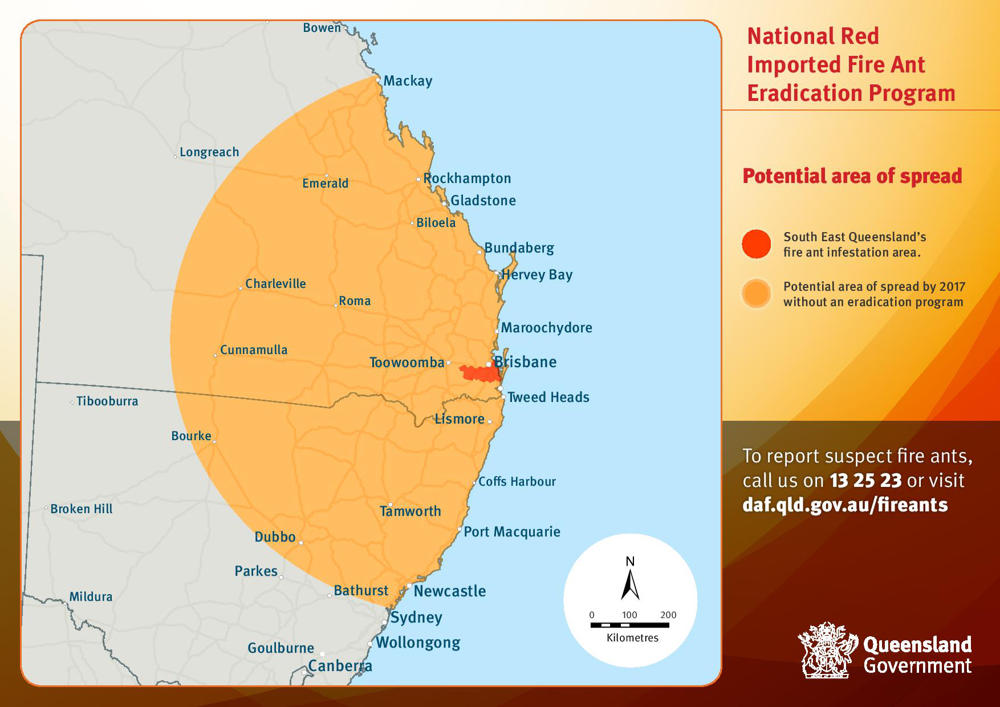Fire Ants: Fighting Fire with Fire
This episode is all about the battle to stop the deadly Red Imported Fire Ant. The Department of Agriculture and Fisheries’ Fire Ant Eradication team is leading a national effort to stop the ants from spreading beyond southeast Queensland. With Dr Ross Wylie and Dr Liz Williams, we discover why the ants are considered ‘super pests’ and how they can devastate homes, backyards, farming land and livestock. We also hear from Queensland farmer Geoff Freiberg who has seen the fire ants in action up close.
Meet our guests
Transcript
Host: Right in the heart of south east Queensland, there’s a battle raging. The enemy is small – between 2 and 6 millimetres long…and there are millions of them. They’re incredibly smart and have some incredible firepower. If they’re not stopped, they could destroy crops, ruin homes, kill livestock…and even humans. But slowly, gradually, we’re winning the war, and the rest of the world is taking notice.
G’day I’m Danielle Jones and Welcome to Turf’n’Surf’ –the official podcast of Queensland’s Department of Agriculture and Fisheries. Shaping and protecting food and fibre for tomorrow’s Queensland. In this podcast we’ll take you inside the battle against the fire ant, a super pest that’s destroyed lands and livelihoods around the world. We’ll talk to the people who spend every day out in the field finding and destroying these insidious pests, and look at how you can help join the fight.
Fire Ants are native to South America but very seasoned travellers. Doctor David Oi is an entomologist with the United States Department of Agriculture.
Dr David Oi: Initially the area around Mobile, Alabama area, that area but then it really expanded quickly through the nursery industry At that time they didn’t have any quarantines or anything so it was being spread through the nursery industry, at least a lot of it So right now there is about I guess it’d be 140 million hectares of land in the United States that is infested with red imported fire ants This area encompasses from Virginia, the coastline in the southern part of Virginia all the way down the coast, all the way to Florida and it actually goes to some of the Caribbean Islands.
Host: The ants haven’t stopped there. They’ve now swept through parts of Asia including China before making their way here to Australia in 2001. Doctor Liz Williams is from Queensland’s Fire Ant Eradication program.
Dr Liz Williams: So the majority of you know typical native ants in the backyard usually have colonies of only a few thousand ants at the most whereas mature fire ant colonies, they actually have been found to have up to 400,000 ants in them so quite the difference to our little native ants that are running around.
The other thing is that most native ants usually only sting people when they are feeling threatened so if you accidentally stand on top of them. Whereas fire ants on the other hand are highly aggressive and also highly territorial so any perceived threat that they see to their nest means they will actually come out and attack with thousands of ants.
If I was to think about my own back yard for an example you know we love having friends and family around on the weekend for a barbecue and the kids often run around on the lawn chasing each other and rolling about With fire ants the kids couldn’t do that and even us sitting down to lunch outside without being stung would be quite difficult. And we have a dog as well so she would need to pretty much become an indoor dog and there would be no ball paying in the backyard with her either And then when I think about other things that you know we enjoy in our backyard is that you know we have lots of native lizards and frogs that occupy our gardens and our ponds and all of these would be killed if we had fire ants. So pretty much anything that we do or our pets do or any other animals that are in the backyard they would all be impacted by fire ants.
Fire ants can cause injury and death So fire ants particularly like to sting the soft skin tissue of animals including the eyes that can cause blindness.
Host: As program science leader, Ross Wylie has seen first-hand how the fire ant survives, thrives and invades.
Dr Ross Wylie: This particular ant has got two social forms. It is either a monogyne which means a single Queen form, or a multiple Queen form and both have got their strengths and that’s why the ant is so difficult The monogyne form can fly up to 5 kilometres so imagine trying to contain a flying insect that can just go over your head for five kilometres. The polygyne form, the multiple Queen very easy to move with goods and materials so it’s a very good hitchhiker so it comes from a difficult area in South America that floods a couple of times a year, is used to disturbance so the ant is capable of rafting Grab their little claws together and form a raft as the water rises up through their nest they will all go to the top of the nest and they all gather at the top of the nest They will link their little claws and form a raft then they will load the Queen on board and then they will load the kids on board and then they will load some food on board and then as the water rises they will float off and they can float for two or three weeks until they come to dry land or a place that they can start a nest again So you imagine in the, some of the rain that we have had recently in the 2011 floods and 2013, you know there was a lot of rafting went there so when that happens there’s nothing much you can do to prevent that spread So that’s one survival mechanism.
Yeah they have got all sorts of habits They can go into areas that you wouldn’t expect them to go into, individually an ant is not all that smart But when you put a whole group of ants together then they can act collectively, it’s almost like thinking and fire ants do do that so they can solve problems and I have seen this happen a number of times An example is in our laboratory at one stage we often test whether the ant can survive in certain materials To do that we put the materials in the bottom of a plastic box We then get a colony of fire ants and put them in the box We give them little bit of water in a jar and we wait and see what happens If they don’t like the material, if they can’t survive in it then they usually huddle in the corner and do nothing but in this particular case that we were watching the ants sat there in the corner for about two hours then somebody got a bright idea then they went over to the water bowl and they picked up this material individually and they threw it all into the water bowl until it displaced all the water or soaked it all up then they went into the water bowl and emptied all the material that had been in there Then they went back to the corner and grabbed the kids and the Queen. Bought them back, put it in the empty water bowl and then used the wet material to make a nest over the top of the bowl and they were as happy as Larry so problem solving.
But they do communicate, they communicate by pheromones so they talk to each other by the release of all these chemicals Where to find food, an alarm pheromone to tell you if the nest is being attacked They even have a death pheromone so that ants, fire ants have their own cemeteries which is outside the nest So if an ant dies they pick up the body and cart it out and put it in the cemetery. The way they proved that there was in fact a pheromone associated with this is that they managed to put that pheromone onto a live ant and when they did all the other worker ants grabbed the one that had that pheromone, took it to the cemetery, no, no I am not dead it said but as far as they were concerned it was so out to the cemetery it went. This is just how they communicate, they are clever little insects.
Host: You’re listening to Turf’n’Surf’ –the official podcast of Queensland’s Department of Agriculture and Fisheries. Shaping and protecting food and fibre for tomorrow’s Queensland.
The Fire ant problem in Australia has been contained to parts of southeast Queensland, in and around Brisbane. But as Ross Wylie explains, the Commonwealth and state governments are spending 400-million dollars over the next ten years to get rid of the ants once and for all.
Dr Ross Wylie: We are going to have to divide it up into sections so there will be four eradication areas We have now started, we are in the second year of treating area one which is the one towards our western part of the infestation and gradually over the next number of years, four or five years we will move from west to east. But first we have to demonstrate that we can eradicate it in the west And the other challenge for us is going to be what happens in the other areas where we aren’t actually putting those eradication treatments on so we are going to have to respond to findings in those other areas, we’re going to have to try to dampen down or suppress some of the heavier infestations, we have got quite a few heavy infestations in the eastern part and we are going to have to contain Now we know that that area is going to spread but we have got to contain it as much as we can so we will need to stop it moving further south as much as we can and moving further west and that is why the big treatment is starting in the west.
You know we are using insect growth regulators so these are a product that mimics a natural hormone in the ant What it does, it doesn’t actually kill ants, it sterilises the Queen The Queen’s ovaries dry up, she is not laying eggs. No new ones coming along and the colony eventually dies, this can take several months to achieve that To do it properly you need to do it the required number of times so we’re doing it three times a year for two years So, this is so that once the Queen is sterilised her ovaries remain sterile, she doesn’t recover We need to do it at the right intervals and the other thing is that you can’t do it piecemeal and that’s what people need to understand is that I could go on a property and I could clear a property but it’s no good unless I clear all the properties around because the ants will just fly straight back in and you’re reinfested so it has to be over large areas And the area that we are doing in the west at the moment is something like 160,000 hectares which is a big lump of land and when we move it will be like a rolling maul Once we have cleared an area we are going to have to protect it from further infestation so there is going to have to be buffer zones as we move from west to east.
But we know our baits work, we know that system works, it’s just a case of making it happen, make it happen on the ground Where we can we use aerial application because that’s the cheapest and most effective way to get our baits on Where we are dealing with residential areas, it’s much more difficult. You can’t put a helicopter over there so we have to go on the ground and that could be 8 to 10 times more expensive than applying that bait by helicopter So we are going to be relying quite a lot on the public as we have done over the years to report We are looking at self-treatment for landholders so that’s in the areas where we are not eradicating, just to try to hold it We are going to need the public help to do that, if we don’t we are going to lose it anyway.
Host: The fight to eradicate fire ants is happening right here in the streets and farms of south east Queensland.
When Geoff Freiberg found a nest on his Mount Walker property southwest of Brisbane, he rang officers at Queensland’s Fire Ant Eradication Program straight away
Geoff Freiberg: From July 2013 to when the last, the last nest that was treated here was the 13th of the second 2018, it was only one nest and before then it was on the 11th of the seventh 17 when we treated nine nests. Leading up to that period there was 186 nests treated.
You know there was a few things we had to adhere by. When the baiting program started like with the allegation and sometimes that’s a bit difficult but you have just got to you know accept that they have got to do what they have got to do and you know it might hold you up irrigating for a couple of days but that’s nothing really when you consider that if we don’t get rid of them it’s going to be a lot worse than just getting held up from irrigating for a couple of days.
Going by the way they multiplied them two years when we really had the good wet weather that the fire ants like, where we were cultivating and irrigating I think it would have been just a mat of fire ants, they would have been everywhere I believe yeah.
Host: In a suburban park in suburban Logan, Justin Gibson from Queensland’s Fire Ant Eradication Program is taking his dog on a hunt for fire ant nests
Justin Gibson: We actually imprint them on the pheromone of the ant so they are actually looking through the grass and through the garden beds and any sort of vegetation where the fire ant may inhabit to try to detect that particular pheromone of that particular ant species which in this case is fire ants. Because we use play reward with our toys, they don’t care if it was an ant, a beetle, a BMX bike, it doesn’t matter, whatever it is that they’re looking for that it then stimulates that game to start, that’s all they care about So for them they find their odour Once they have found that target odour they will be looking at us to get rewarded.
I don’t want to be biased. You know from my perspective the dogs do play a crucial role because the advantage of what we do is we don’t have to visually go and see a nest, they can find like you said the stragglers or the little incipient colony which is the new colony starting out, they can assist with product movement where you know massive amounts of soil have been disturbed and then spread somewhere else You know, there may not be a nest established that is visually obvious at that stage, the dogs can actually come in and find the ants that might be out foraging and starting to re-establish So that’s where they have their own little niche if you will so they are an advantage to that.
But the program as a whole has many, many aspects Like we are just a tiny, a tiny stone in the pond if you will as far as what this program offers. We have got helicopters, we have got ATVs, we have got massive amount of foot crew We have got nest injection trucks, we have got blower vehicles, we have got operational teams producing maps of work and taking calls from the public, it’s just ongoing so we’re just a very small component of that.
We have an education program that goes out to schools as well that also takes one of our retired dogs out and actually does a bit of a demonstration for the kids and raises their awareness because let’s face it, they are in the backyard playing all the time, they are down at the park playing all the time so if we can educate them young and get them to report and talk to mum and dad and get mum and dad to report it has a massive impact on actually having us extra eyes looking.
Host: Justin’s sniffer dogs are only one small part of the war against fire ants.
Ross Wylie says public help is still the key.
Dr Ross Wylie: The thing about fire ants is they are a super pest. Generally if you get a pest you know it’s a pest of strawberries or it’s a pest of cotton or it’s a pest of this or that or it is a pest to the environment or it’s a nuisance Fire ants are everything. They affect the environment, they will affect the economy, they will affect social life. So a lot of those impacts have been avoided, the cost that we worked out was it would cost our economy 1.6 billion dollars a year if fire ants get out of control way across Australia And you compare that with the money that we are putting in at the moment, over a 10 year period it’s 400 million So I think it’s good value for money and even if we didn’t eradicate and couldn’t eradicate I would still recommend that we kept on aggressively trying to contain the ant which is the same as what we are doing at the moment So I hope we never give up and I hope the public stay onside I hope the governments support us.
Host: Farmer Geoff Freiberg agrees eradicating fire ants needs a wider community approach.
Geoff Freiberg: They have got to sit down and realise that it is no good pointing the finger and blaming somebody, I mean we have got them right Now it is a big country and it’s no good saying biosecurity you know they are the problem that they got in here Well everybody is human, these things are going to happen so they have got to rethink and say listen, there is only one thing to do and that is work with bio security You know they are good people, they are easy to talk to, they are only too willing to help and you know report them and be like on the lookout for them and as soon as you see one report it and you know don’t go pointing fingers and being negative because you know in 10 years’ time when this 400 odd million is up, that will be the end of it, if it’s not gone by then that we will have them forever.
Host: Thanks for listening to Turf’n’Surf, the official podcast of the Queensland Department of Agriculture and Fisheries. For more information about this edition’s topic head to our website www.daf.qld.gov.au



